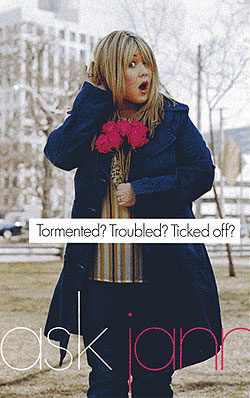“Sex does not a relationship make,” Jann Arden advises. “Dating is a tool used to weed out the wackos.”
The question “So Confused” had asked Arden was whether she ought to stop looking around, now that she and her date had slept together. In the December 2005 issue of Elle Canada, the advice columnist finished her answer encouraging “So Confused” not to be so eager to leave the dating scene:
“Keep doing it until you meet the person who absolutely makes your head spin like a drunken nun.”
The Canadian singer/songwriter is just one in a long list of celebrities adding journalism to their multi-faceted resumés. The Juno Award-winning Arden began writing her advice column for Elle Canada last May. She’s the third in the magazine’s run of celebrity advice columnists since January 2002. Mary Walsh, formerly of This Hour Has 22 Minutesand currently of Hatching, Matching and Dispatching, was the first, followed by Pamela Anderson, who needs no introduction.
Elle Canada editor Rita Silvan and managing editor Noreen Flanagan both say the advice is real. Flanagan sends out the questions and the columnists take it from there. Anderson even faxed columns in her own handwriting. “Everyone has always handed in their copy on time … well, except for Mary,” laughs Silvan. “Oh, and Pam every once in a while, but she wasn’t bad.” Flanagan, who adds, “Jann: full marks,” did call Arden shortly after she began writing to see if she was aware that her responses could sound judgmental. The singer modified her answers, but Silvan still thinks Arden’s advice is funny. “It’s a little tough, but also compassionate.”
Celebrity columnists aren’t writers, so why do they get to jump over hardworking journalists to get gigs? Dr. Kay Hays, a Toronto psychologist who specializes in performance psychology, likens it to the halo effect. “If you think or feel about someone in one way,” she says, “it can spread to thought or feeling in another aspect of their lives.” For example, if you’re watching a television show in which you identify with and admire a character, you might decide she’d be knowledgeable about your love life too.
The celebrity columnist phenomenon is also big in the United States. To name a few examples, Anderson wrote another column for Jane magazine, musician John Mayer wrote an article for Esquire in July 2004 and author Stephen King is a pop-culture writer for Entertainment Weekly. Moreover, controversial filmmaker Michael Moore covered the 2004 Republican Convention for four days in USA Today and the Miami Herald‘s “Advice Diva” Tara Solomon features guests regularly, like actor Amanda Bynes and singer Kelly Osborne.
Here in Canada, enRoute‘s September 2005 issue published articles in which Michael Bublé interviewed Nelly Furtado, Carl Newman of the New Pornographers chatted up Ron Sexsmith and Arden talked to Leslie Feist. Even Wayne Gretzky contributes hockey expertise to the National Post.
The trend isn’t new, but it’s growing. Debbie Travis, made famous by her television show Debbie Travis’ Painted House, has a syndicated advice column about – what else – home decorating. The Hamilton Spectator has run it for at least five years, and style editor Michelle Steeves says the appeal is based on the décor expert’s profile. Travis’s syndicated column appears in 18 newspapers in this country and – an anomaly for a Canadian columnist – 53 in the U.S.
While many celebrity columnists offer advice, some write strictly from personal experience. David Veitch, the Calgary Sun sports editor, handled former professional wrestler Bret “Hitman” Hart’s column in the final three years of its seven-year run, until 2004. According to Veitch, the Sun approached Hart with the idea of writing a column. To their surprise, he said yes. In-house surveys revealed that Hart’s column – based on his wrestling memories – was popular. However, Veitch says the number of people surveyed was too low to reach any definite conclusion. Hart’s grammar and spelling were fine and his copy came in fairly clean, but he had a tendency to spell certain names wrong. Sometimes the column was “squashed” over potentially libelous comments regarding Hart’s fallout with the then-named World Wrestling Federation. “There are some things you can’t write,” Veitch says, “even in a column.” Many journalists, not just celebrity columnists, watch their columns get killed for the same reason.
Canadian professional golfer Mike Weir is another celebrity whose content is fluffy, and in his case the stereotype of the ghost-written celebrity columnist is the reality. Michael Grange, a sports writer for The Globe and Mail, writes five Weir columns a year as part of a sponsorship deal. The columns offer the golfer’s personalized previews of the four “majors” – the Masters, the U.S. Open, the British Open and the PGA Championship – and the Bell Canadian Open. Grange chats with Weir about what’s going on inside the golfer’s head going into the big events, and writes it up. With this pre-tournament access, the Globe gets a leg up on competition – other outlets are still busy arriving at tournaments on Mondays when the Globe runs Weir’s thoughts. Sports editor Steve McAllister isn’t sure if the column, which has been running at least five years, improves readership, but he says the paper always runs a “skybox” at the top of Page One to throw readers to the column.
A discussion of a celebrity columns isn’t complete without Sir Richard Branson’s stint “editing” the August 2005 issue of National Post Business (now Financial Post Business). Editor Brian Banks says the magazine wanted a guest editor to spice up content in the late summer issue, one usually weak in advertising. The flamboyant mogul’s name came up because he had recently launched Virgin Mobile in Canada. For the feature he was writing, Banks was allowed to hang out with Branson for two days and be “a fly on the wall.” The editor used the opportunity to toss around the issue’s theme – adventure lifestyle – with Branson and get his input. In addition to being the subject of the cover story, he wrote two small pieces and his “Branson’s Picks” travel destinations were placed near the end of the book. He also suggested Banks assign a piece about world record adventurer Steve Fossett. Banks says the stories with Branson’s byline were based on interviews, and then traded over email, but overall they weren’t heavily rewritten. The billionaire received no financial compensation.
As it turns out, Branson was an exception. As if the free publicity weren’t enough, celebrities get paid for their work. Veitch said Hart received money, but wouldn’t reveal exactly how much. Weir’s sponsorship deal obviously involved financial compensation. And Walsh, Anderson and Arden all received the standard magazine freelance fee for their columns. Imagine, Silvan says, “Pam, working for a dollar a word – a Canadian dollar!” One of her columnists hasn’t invoiced the magazine, but Silvan won’t say who. “You know they’re doing it because they love to do it,” she says. “Each one has been honoured and flattered to be asked to reach out to Canadian readers.”
While the celebrity draw is obvious and becoming more prevalent, publications don’t take the work too seriously. McAllister says, “It’s not going to be hard-hitting journalism,” in reference to Weir, “but it’s good for insight.” The articles steer away from the nuts and bolts of golf, he says, so even people who aren’t golf fans can enjoy the column.
Flanagan says of her Elle Canada column, “It was never meant to be, ‘Oh, this is exactly what I have to do with my life.’ It was never meant to be, ‘This is a serious, serious bit of journalism.'”
So journalists, rest easy. Newspapers and magazines might sell more with star-studded articles, but editors know you can’t replace the real thing.
About the author
Catherine Muss was the Director of Circulation for the Summer 2006 issue of the Ryerson Review of Journalism.



